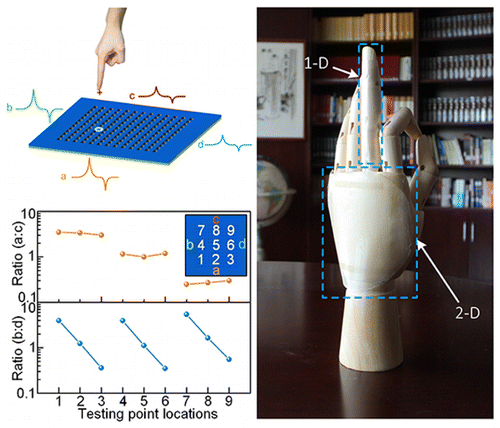Robots could get 'touchy' with self-powered smart skin

Smart synthetic skins have the potential to allow robots to touch and sense what's around them, but keeping them powered up and highly sensitive at low cost has been a challenge. Now scientists report in the journal ACS Nano a self-powered, transparent smart skin that is simpler and less costly than many other versions that have been developed.
Endowing robots and prosthetics with a human-like sense of touch could dramatically advance these technologies. Toward this goal, scientists have come up with various smart skins to layer onto devices. But boosting their sensitivity has involved increasing the numbers of electrodes, depending on the size of the skin. This leads to a rise in costs. Other systems require external batteries and wires to operate, which adds to their bulk. Haixia Zhang and colleagues wanted to find a more practical solution.
The researchers created a smart skin out of ultra-thin plastic films and just four electrodes made from silver nanowires. Other prototypes contain up to 36 electrodes. Additionally, one component harvests mechanical energy—for example, from the movement of a prosthetic hand's fingers—and turns it into an electric current. Therefore, the skin wouldn't need an external power source. Testing showed that the skin was highly sensitive. It could "feel" a honeybee as it flew toward and away from the device. It also demonstrated electrical stability, maintaining the same level of output over 30,000 cycles.
More information: Mayue Shi et al. Self-Powered Analogue Smart Skin, ACS Nano (2016). DOI: 10.1021/acsnano.5b07074
Abstract
The progress of smart skin technology presents unprecedented opportunities for artificial intelligence. Resolution enhancement and energy conservation are critical to improve the perception and standby time of robots. Here, we present a self-powered analogue smart skin for detecting contact location and velocity of the object, based on a single-electrode contact electrification effect and planar electrostatic induction. Using an analogue localizing method, the resolution of this two-dimensional smart skin can be achieved at 1.9 mm with only four terminals, which notably decreases the terminal number of smart skins. The sensitivity of this smart skin is remarkable, which can even perceive the perturbation of a honey bee. Meanwhile, benefiting from the triboelectric mechanism, extra power supply is unnecessary for this smart skin. Therefore, it solves the problems of batteries and connecting wires for smart skins. With microstructured poly(dimethylsiloxane) films and silver nanowire electrodes, it can be covered on the skin with transparency, flexibility, and high sensitivity.
Journal information: ACS Nano
Provided by American Chemical Society




















